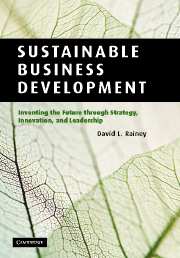Book contents
- Frontmatter
- Contents
- List of figures
- List of tables
- List of boxes
- List of abbreviations
- Acknowledgments
- Introduction
- Part I Enterprise thinking, the driving forces of change, and leadership
- 1 Sustainable business development: overview and guiding principles
- 2 Enterprise thinking and the strategic logic of strategic business development
- 3 Crafting sustainable business strategies and solutions
- 4 The driving forces of social-, economic-, and environmental-related change
- 5 The driving forces of markets and stakeholders' connectedness
- 6 Crafting a sustainable enterprise through leadership and capabilities
- Part II Innovation management, life cycle considerations, and insights
- Glossary
- Select bibliography
- Index
- References
1 - Sustainable business development: overview and guiding principles
from Part I - Enterprise thinking, the driving forces of change, and leadership
Published online by Cambridge University Press: 04 December 2009
- Frontmatter
- Contents
- List of figures
- List of tables
- List of boxes
- List of abbreviations
- Acknowledgments
- Introduction
- Part I Enterprise thinking, the driving forces of change, and leadership
- 1 Sustainable business development: overview and guiding principles
- 2 Enterprise thinking and the strategic logic of strategic business development
- 3 Crafting sustainable business strategies and solutions
- 4 The driving forces of social-, economic-, and environmental-related change
- 5 The driving forces of markets and stakeholders' connectedness
- 6 Crafting a sustainable enterprise through leadership and capabilities
- Part II Innovation management, life cycle considerations, and insights
- Glossary
- Select bibliography
- Index
- References
Summary
Introduction
Overview
Leading business corporations in the industrialized world are changing their SMSs to incorporate the principles, strategies, processes, and practices of SBD. They are moving from the company-centric structures of the twentieth century to highly interactive management constructs framed in the global context of the social, political, economic, environmental, market, and technological realities of the twenty-first century. The transformation process is subtle and involves evolutionary changes that have been dramatically reshaping the business world since the 1970s. With globalization, technological changes, economic drivers, and social and environmental mandates, the global business environment is less predictable and more challenging than it was even a decade ago. Customers, stakeholders, and society expect and demand superior products, services, and operations with less waste, reduced impacts on health, safety, and the environment, and enhanced corporate responsibilities for the decisions, technologies, products, processes, and activities of every facet of the business enterprise. Moreover, these expectations also apply to the operations, actions, and contributions of supply networks, partners, allies, and others that are directly and indirectly linked to the corporation.
The implications of such expectations and demands are profound. Leading and managing a large corporation has become more complex and challenging, yet also more exciting and rewarding. Corporations have broadened the scope of their thinking and include many more considerations in their decision-making. They have moved beyond concentrating on core competencies in order to satisfy customers with high-quality products: that thinking characterized the 1990s.
- Type
- Chapter
- Information
- Sustainable Business DevelopmentInventing the Future Through Strategy, Innovation, and Leadership, pp. 13 - 71Publisher: Cambridge University PressPrint publication year: 2006



